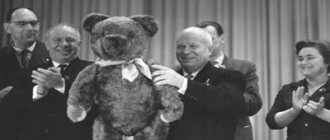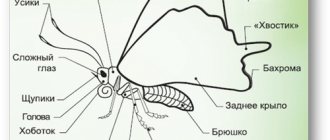Lesson No. 1 on the topic “The Age of Dinosaurs.” Chapter 4. History
The work can be combined with video materials and presentation of sections of the material. Students will find a lot of interesting information and questions to answer as the lesson progresses. The questions are based on the text part of the textbook. The methodology was developed in accordance with the Federal State Educational Standard.
Full version of the development of lessons and quizzes for the History chapter
Type of lesson:
Generalization and systematization of knowledge
Target:
development of erudition, cognitive and creative abilities of students; developing the ability to search for information to answer questions.
Tasks:
Educational
: the formation of cognitive culture, mastered in the process of educational activities, and aesthetic culture as the ability to have an emotional and value-based attitude towards objects of living nature.
Educational:
development of cognitive motives aimed at obtaining new knowledge about living nature; cognitive qualities of a person associated with mastering the fundamentals of scientific knowledge, mastering methods of studying nature, and developing intellectual skills;
Educational:
orientation in the system of moral norms and values: recognition of the high value of life in all its manifestations, the health of one’s own and other people; environmental awareness; nurturing love for nature;
UUD
Personal
: understanding of responsibility for the quality of acquired knowledge; understanding the value of adequately assessing one’s own achievements and capabilities;
Cognitive
: ability to analyze and evaluate the impact of environmental factors, risk factors on health, the consequences of human activities in ecosystems, the impact of one’s own actions on living organisms and ecosystems; focus on continuous development and self-development; the ability to work with various sources of information, convert it from one form to another, compare and analyze information, draw conclusions, prepare messages and presentations.
Regulatory:
the ability to organize independent completion of tasks, evaluate the correctness of work, and reflect on one’s activities.
Communicative:
the formation of communicative competence in communication and cooperation with peers, understanding the characteristics of gender socialization in adolescence, socially useful, educational, research, creative and other types of activities.
Technologies:
Health conservation, problem-based, developmental education, group activities.
Lesson structure
:
1. Preparatory conversation,
2. Conversation - reasoning about previously acquired knowledge on a given topic,
3. Watching video material (film)
Animated GIF video. Age of Dinosaurs
Animated GIF presentation “The Age of Dinosaurs”
/data/files/m1559653390.pptx (presentation “The Age of Dinosaurs”)
Age of Dinosaurs
Millions of years ago, strange reptiles called “dinosaurs” reigned on Earth. They most likely appeared about 210 million years ago and became completely extinct about 65 million years ago.
The first people appeared on Earth only about two million years ago. For millions of years, our planet was inhabited by hundreds of different species of dinosaurs, but none of them have survived to this day.
What was the Earth like in those distant times?
During the age of dinosaurs, most of the Earth had a very hot climate. The land was covered with vast swamps and tropical thickets. This habitat was quite suitable for dinosaurs and other reptiles.
Were all dinosaurs big?
Not all. Some, for example Compsognathus,
were no bigger than a large turkey.
Although stegosaurus
was 7 m long, its brain was only the size of a walnut.
Do you know the largest dinosaur?
This is a Brachiosaurus lizard.
It was longer than two buses put together, and you could sit in its footprints.
Which dinosaur was the most ferocious?
Tyrannosaurus rex
was the largest predator that ever lived on Earth. He had teeth the size of daggers.
Why did dinosaurs become extinct?
Nobody really knows why dinosaurs went extinct. The most likely reason for their extinction could be climate change, which led to a shortage of food for dinosaurs
How are fossils formed?
1. The flesh of a dead animal decomposes, leaving only parts of the skeleton.
2. Bones end up buried under a layer of silt, sand and rotting plants
3.As this layer becomes thicker, the loose mixture is compressed into solid rock.
4.For millions of years, the bones absorbed minerals from the surrounding rock.
5. As a result, the bones themselves become part of this rock (that is, they become fossilized). From these fossilized remains one can judge what certain extinct creatures looked like during life.
HOW
LIFE ORIGINED ON EARTH
THE HISTORY OF OUR EARTH
THE ERA
OF DINOSAURS - GIANTS .
How are fossils formed?
'How life conquered the Earth' Educational cartoon for children
Ancient
fossils .
_ Online convector
https://fconvert.ru/video.
YouTube
video conversion site https://www.onlinevideoconverter.com/ru/youtube-converter
Resources:
Paul Dowswell's
The Unknown About the Known, a study guide for continuing education. Chapter 4 History
Educational portal
https://cleverpenguin.ru/metabolizm-kletki
School world INFO https://www.shkolnymir.info/content/view/95/9
FB.ru
https://fb.ru/article/198783/hvostatyie-zemnovodnyie-samyie-yarkie-predstaviteli etogo-otryada
YouTube website
: https://www.youtube.com/
Presentation hosting
— https://ppt4web.ru/nachalnaja-shkola/prezentacija-k-uroku-okruzhajushhego-mira-vo-klasse-chto-takoe-ehkonomika.html
World of dinosaurs presentation for class (senior group) on the topic
Slide 1
Developed by: Blifer Nikita, 5 years old senior group Ovsyannikova Liliya Sergeevna World of Dinosaurs
Slide 2
Dinosaurs are mysterious creatures that inhabited the planet millions of years ago. They excite people's imagination and arouse their keen interest. Although everyone imagines dinosaurs only from drawings, they have become quite realistic modern figures, coming to life in toys, cartoons, fairy tales, poems, and films. Like many children, for my child they are one of the most popular heroes. First, my son saw dinosaur figurines in a store, we started collecting them, then he began to convey his thoughts about these creatures through drawings. Having discovered the obvious and enormous PREFACE
Slide 3
Given the child's interest in dinosaurs, it was clear that it was necessary to deepen his knowledge in this area. We started looking for various books and children's encyclopedias about them, and looked through information on the Internet. The child absorbed everything new like a sponge and became more and more interested in dinosaurs. The conversations both at home and in kindergarten were only about them. As a result, we decided to prepare this presentation with him and show it to other children and their parents, the slides were accompanied by his own story about these amazing creatures.
Slide 4
Dinosaurs are reptiles that inhabited the Earth millions of years ago. People learned about them by discovering their fossils in the earth.
Slide 5
Ever since the first fossils were found, people have been interested in these magnificent reptiles. REMAINS AND TRACES OF DINOSAURS The remains and traces of dinosaurs are called fossils.
Slide 6
Science PALEONTOLOGY People who study the remains of dinosaurs and lead excavations are called PALEONTOLOGISTS. The science that studies dinosaurs is called PALEONTOLOGY.
Slide 7
Theropods Ceratopsians Pachycephalosaurs Ornithopods Stegosaurs Ankylosaurs Sauropods Dinosaur families
Slide 8
THEROPODS Tyrannosaurus Rex
Slide 9
and waited for the prey to come closer, and then attacked from ambush. The tyrannosaurus had dozens of teeth, and new ones grew to replace the broken and knocked out ones. Tyrannosaurus Rex was a large predator. It was named Tyrannosaurus Rex, which means “king of the tyrant lizards.” But he moved slowly and clumsily, so while hunting, he hid
Slide 11
For 100 years after its discovery, Tyrannosaurus rex ranked first among the largest predatory dinosaurs known to us.
Slide 12
THEROPODS Giganotosaurus
Slide 13
Giganotosaurus was a huge and dangerous predator.
Slide 15
Giganotosaurus was larger than Tyrannosaurus rex in size and weight, but inferior to it in brain size. The shape and size of his brain resembled a banana.
Slide 16
THEROPODS Compsognathus
Slide 17
Compsognathus is the smallest dinosaur. But Compsognathus ran very quickly and easily escaped from large predators. He hunted lizards, small mammals and large insects.
Slide 19
Compsognathus is the smallest dinosaur known to us. Compsognathus was the size of a chicken, but this does not mean that it was weak and defenseless.







